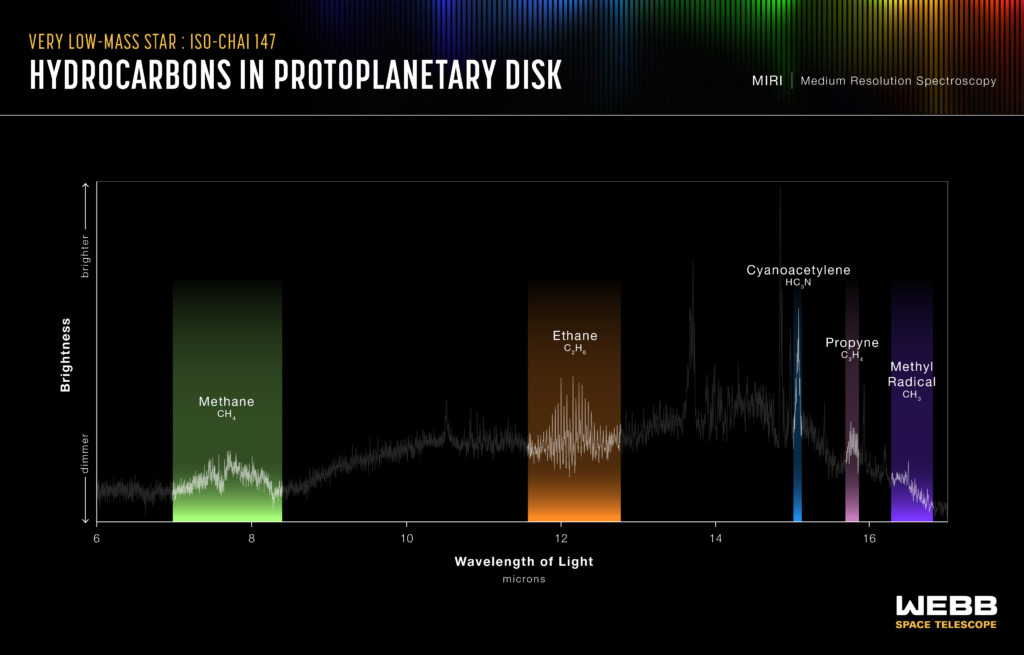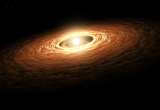James Webb finds plethora of carbon molecules in disks around very low-mass stars
An international research team involving scientists from IAS and other laboratories has just revealed the chemical composition of a disk of matter rotating around a young star, where new planets are forming. The results reveal the largest number of carbon-containing molecules observed to date in such a disk, and have implications for the potential composition of planets that could form around this star. These results, published in the journal Science, were obtained as part of the MIRI instrument's guaranteed time program, developed by a consortium of laboratories in Europe and the USA and involving the IAS.
Rocky planets are very common around very low-mass stars, as demonstrated by the famous TRAPPIST-1 planetary system. Yet little is known about the chemistry of these worlds, which may be similar to or very different from Earth. By studying the disks from which these planets form, known as protoplanetary disks, astronomers hope to gain a better understanding of the planet formation process and the composition of the resulting planets.
Protoplanetary disks around very low-mass stars are difficult to study because they are smaller and less luminous than disks around more massive stars. The program called MIRI Mid-INfrared Disk Survey (MINDS) aims to use the unique capabilities of the James Webb Space Telescope (JWST) to link the properties of disks with the properties of exoplanets.
In a new study, this team explored the region around a very low-mass star known as ISO-ChaI-147, a star 1-2 million years old that has just 0.11 times the mass of the Sun. The spectrum revealed by JWST's MIRI instrument shows the richest hydrocarbon chemistry observed to date in a protoplanetary disk - a total of 13 different carbonaceous molecules. In particular, the team detected ethane (C₂H₆) for the first time outside our solar system, as well as ethylene (C₂H₄), propyne (C₃H₄) and the methyl radical CH₃.
"It's incredible that we can detect and quantify molecules that we know well on Earth, such as benzene, in an object over 600 light-years away", explains Agnès Perrin, CNRS researcher at the Laboratoire de Météorologie Dynamique (LMD - CNRS/ENS-PSL/IPP/Sorbonne Université).
"Last year, we had already discovered very large quantities of acetylene (C₂H₂), diacetylene (C₄H₂) and benzene (C₆H₆) in a disk around a similar star. Here, we've discovered an even richer cocktail of molecules, confirming that the disks around this type of star are really like hydrocarbon factories", adds Benoît Tabone, CNRS researcher at the Institut d'Astrophysique Spatiale (IAS - Université Paris-Saclay/CNRS).
These results have important implications for the chemistry of the inner disk and the planets that might form there. As JWST has revealed that the gas in the disk is rich in carbon, it is likely that little carbon remains in the solid materials from which planets would form. As a result, any rocky planets that might form there would ultimately be carbon-poor.
This work underlines the crucial need for scientists to collaborate across disciplines. The team notes that these results and the accompanying data can contribute to other fields, including theoretical physics, chemistry and astrochemistry, in order to interpret the spectra and investigate new spectroscopic signatures of molecules in this wavelength range.
Links:
Contact at IAS: Benoît Tabone

Spectrum of the protoplanetary disk around the star ISO-ChaI-147 revealed by JWST/MIRI.
.




